Chaparral 2E: the car that changed everything
In this extract from his new book on Jim Hall, George Levy tells the story of the revolutionary Chaparral 2E, which gave Can-Am wings

Pete Biro/Revs Institute
While the ‘other half’ of the Chaparral team was off taking on Ford, Ferrari and Porsche around the world in prestigious endurance racing contests, Jim Hall was busy creating his most revolutionary Chaparral yet, the 2E, for a completely different series: the high-stakes, six-race SCCA Canadian-American Challenge Cup that would be contested over an intense two-month period in the autumn.
Creating a brand-new car rather than continuing with the 2A or 2C was the second major decision the team would make for the 1966 season and one that would profoundly affect its future. To understand why, it’s helpful to remember something Hap Sharp, Chaparral team driver, liked to say: “You win championships with last year’s car.”
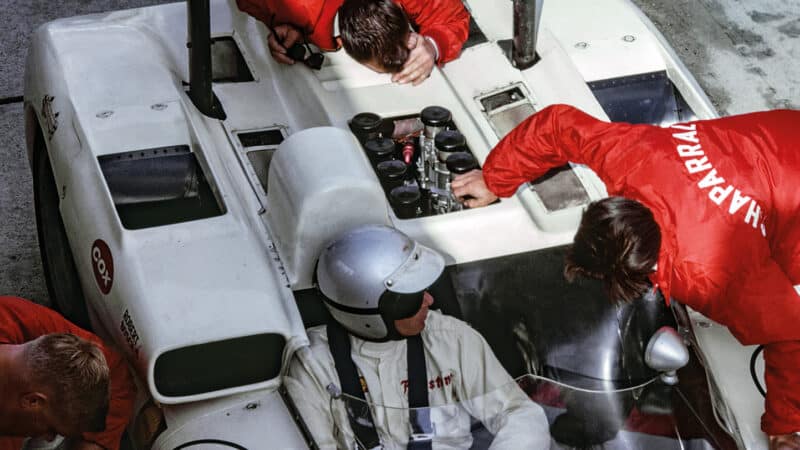
As successful as the 2C had been, Jim Hall had devised something even more groundbreaking in the 2E and was impatient to get it on a track
Bob Gebert courtesy Glen Gebert Photography & Archive
He liked to say it because it contained so much truth. History had shown time and again that a newer design with untested technology, while frequently faster than the car it replaced, often wasn’t yet reliable enough to capture championships. The first modern rear-engined cars came to Indianapolis in 1961 but didn’t win the 500 until 1965. Ford had poured millions into its GT40 programme, but it wasn’t until after successive faceplants at Le Mans in 1964 and ’65 that the car finally captured the race for which it was designed — two weeks after Jim’s 2D won the Nürburgring.
“I learned so much over the course of 1965 that I knew just exactly what we ought to do for our next model,” says Hall, “and I couldn’t wait to build it. So, I started on the 2E. And when Hap and I decided we’d go forward with both the 2D and 2E, that’s where I really got enjoyment, although maybe I was trying to do too much.
“I think we probably could have run 2C and done quite well with it in 1966,” adds Hall, “but you know I’m probably not as focused on winning races as I am on the technology of racing.
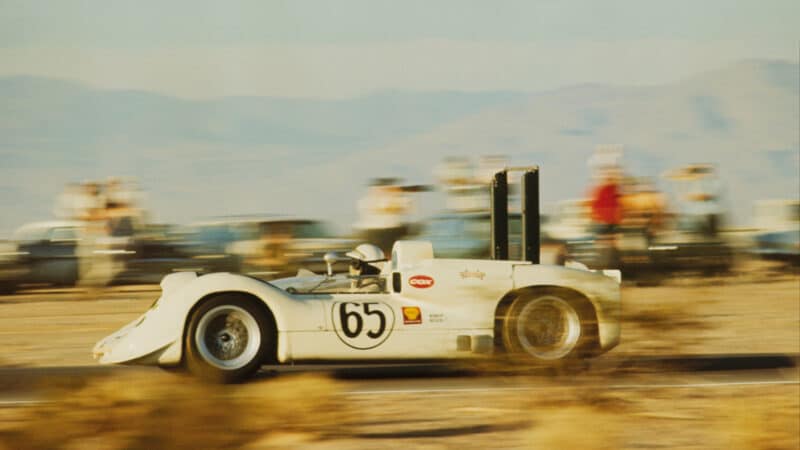
Phil Hill in the 2E in Las Vegas, 1966 – having lost the wing
Getty Images
“I love to win races, because it gives you a good feeling. But I also was in a time in my life where my mind was going full blast. I was working 16 hours a day and I loved it. And I kept wanting to do what I could do to build the best machine that I could build. The 2E had been thought out and it was going to cure almost all the problems that we had on our car for the last three years. I couldn’t wait to bring it to life.”
“The 2E announced that net downforce was the next great frontier in vehicle performance”
The 2E was revolutionary in at least six major ways: first and foremost it was the car that formally announced to the world that net downforce was the next great frontier in vehicle performance. Yes, the 2A achieved net downforce over time and the 2C delivered it from day one. But people didn’t fully appreciate what they were seeing because the concept was so new and the 2A and 2C seemed still to be variations on familiar themes in racing car design.
The 2E was a clean break with everything that had come before in motor sport. Today, net downforce is incorporated from the moment of conception into the design of every vehicle in every major motor racing series – Formula 1, NASCAR, Le Mans, dragsters, winged sprint cars, off-road racers, you name it. Not to mention every ultra-high-performance road car from Corvette to Ferrari to Bugatti to Porsche, Pagani and McLaren. Go back and Hall’s 2E is their single common ancestor.
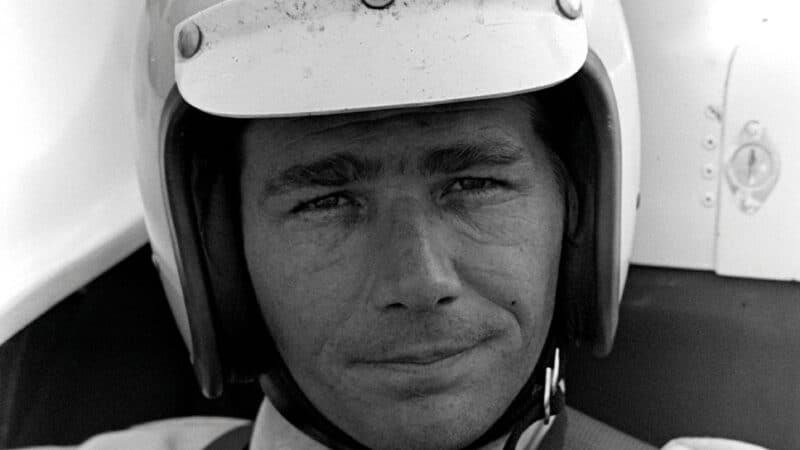
Hall was a genius – and the flimsy rulebook of Cam-Am allowed his creativity to flourish
Getty Images
The next two big ideas were to make the downforce adjustable by the driver, something Hall had pioneered with the flipper wing on the 2C, and to generate balanced download across the front and rear axles regardless of downforce mode, which was completely new.
“Others had tried wings dating back to the early days of the car but no one had stuck with it”
The fourth big idea was to use a wing as the main downforce-generating device. Others had tried wings dating back to the early days of the car, but no one had stuck with it. No one had proven conclusively that wings could work in a racing environment and were, in fact, one of the best ways yet imagined to generate serious downforce.
The fifth big idea was to transmit that download directly to the wheels via the wheel hubs. Previously all experiments in downforce had transmitted their loads through the body, which could upset the pitch of the car. In the 2E, the rear wing struts were mounted directly on the wheel hubs. If the wing generated 500lb of downforce, 500 reached the wheels without upsetting the pitch of the body as much.
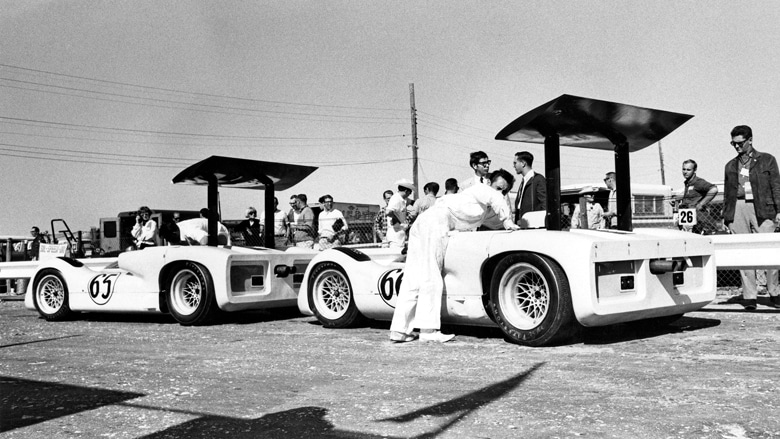
At Bridgehampton in 1966, Jim qualified on pole, but when Hill’s car ran into mechanical issues, Hall turned over his 2E to Hill, meaning Jim’s pole was erased from the history books
Pete Biro/Revs Institute
The sixth big idea was to relocate the 2E’s radiators to the side of the car. Revolutionary not just in terms of performance but safety as well. Since the earliest days, most racing cars had put the radiator at the very front of the car. It seemed the best way to make sure it collected enough fresh air to do its job. But front-mounted radiators put superheated water in front of a driver’s feet, which made it more difficult for him or her to maintain peak effectiveness over the course of a race. Hall proved that moving the radiators to the side of the car could still let them accomplish their primary function – controlling engine temperatures – while increasing rear weight bias, centralising major masses and improving conditions for the driver. It would also open new possibilities for the shape of the nose of the car to minimise drag and optimise downforce.
The architectural implications would trigger a revolution. Hall’s thought process went something like this: how do you make both front and rear downforce systems driver-adjustable? Simple. By continuing with the clutchless torque-converter transmission, you could use the third pedal that controlled the wing on the later versions of the 2A and 2C to operate front and rear downforce systems simultaneously.
“I knew I could produce front downforce with the front-mounted radiator set-up on 2 and 2C,” explains Hall. “With no radiator, I could modulate downforce by controlling the airflow. That was an easy one. Placing the radiator more to the rear had plenty of practical advantages, so I just had to decide where to put it. I knew it would not get as much undisturbed airflow, so I was mindful of making it big enough to provide adequate cooling. A more balanced solution with greater cooling possibility suggested two radiators, one on each side in a position to get adequate airflow. Voilà, 2E: modulated downforce and cooling design.”
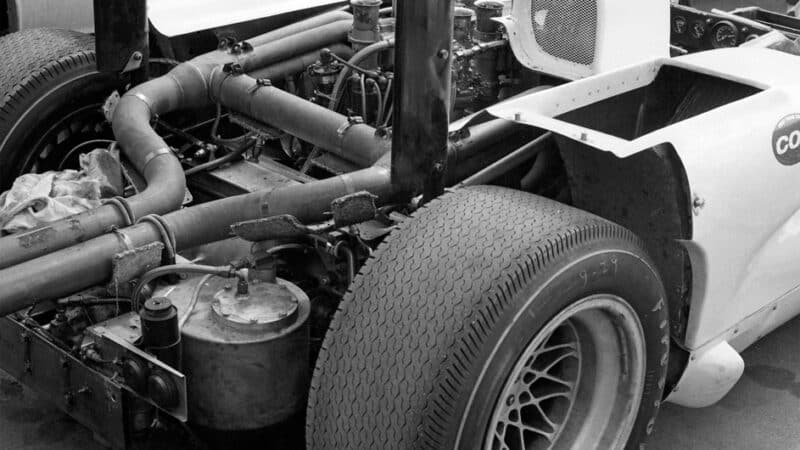
Mounting the 2E’s wing struts to the rear suspension uprights meant that the downforce generated was going directly to the wheels, not to the body
Pete Biro/Revs Institute
Hall modulated downforce at the front with a small flap inside what had been the radiator tunnel that would open and close with the movement of the rear wing. Closed, it would provide low drag. Open, it would generate downforce in synch with the rear wing moving into its high-downforce position, but without disturbing airflow to it. The car would remain aerodynamically balanced in both downforce modes.
Genius.
Of course, the radiators had to go somewhere, and rivals would be shocked a few months later when they saw what looked like the air intakes off a McDonnell Douglas F-4 Phantom on either side of Jim’s shoulders. He had relocated the radiators, plural, to the midsection of the car.
The benefits of this were more than aerodynamic. In addition to lowering cockpit temperatures, the side-mounted radiators also improved weight distribution.
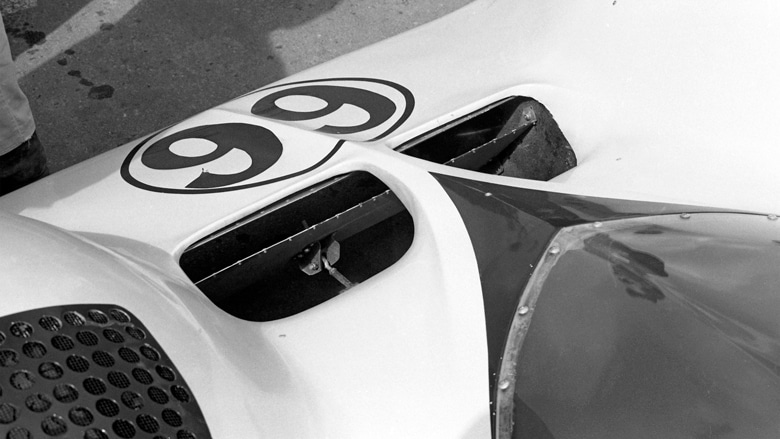
Relocating the radiators to the centre of the car meant the front intake could be devoted to an adjustable downforce device to provide balanced net downforce across both ends of the car
Bernard Cahier / The Enthusiast Network via Getty Images
“This was not just creating a new car but reinventing the racing car”
Over time, Formula 1 and Le Mans cars would copy this innovation as well. In fact, you won’t find an F1 car today that doesn’t have side-mounted radiators. Jim Hall did them in 1966. All of this together constituted not just creating a new car but reinventing the racing car as we knew it.
Building a car as radical as the 2E was an enormous undertaking. How do you make the wing? Where do you put it? How do you mount it to the hubs — which move up and down — and connect it to the same pedal that’s going to activate the downforce system at the front of the car?
One of the first decisions was the shape the wing should be. Most aeroplane wings are asymmetric or ‘cambered’. It’s the longer path the air travels over the top surface that creates the low-pressure area that generates lift. Flip it over and you produce downforce. Hall decided instead that the wing should be symmetrical, like the one they’d used on the 2A and 2C.
It made sense. In the neutral position, symmetrical wings generate less downforce and drag. Perfect for the straightaways. Angle them up and they create downforce.
Rotation was central to the 2E concept. The wing had to move easily from low drag to high downforce.
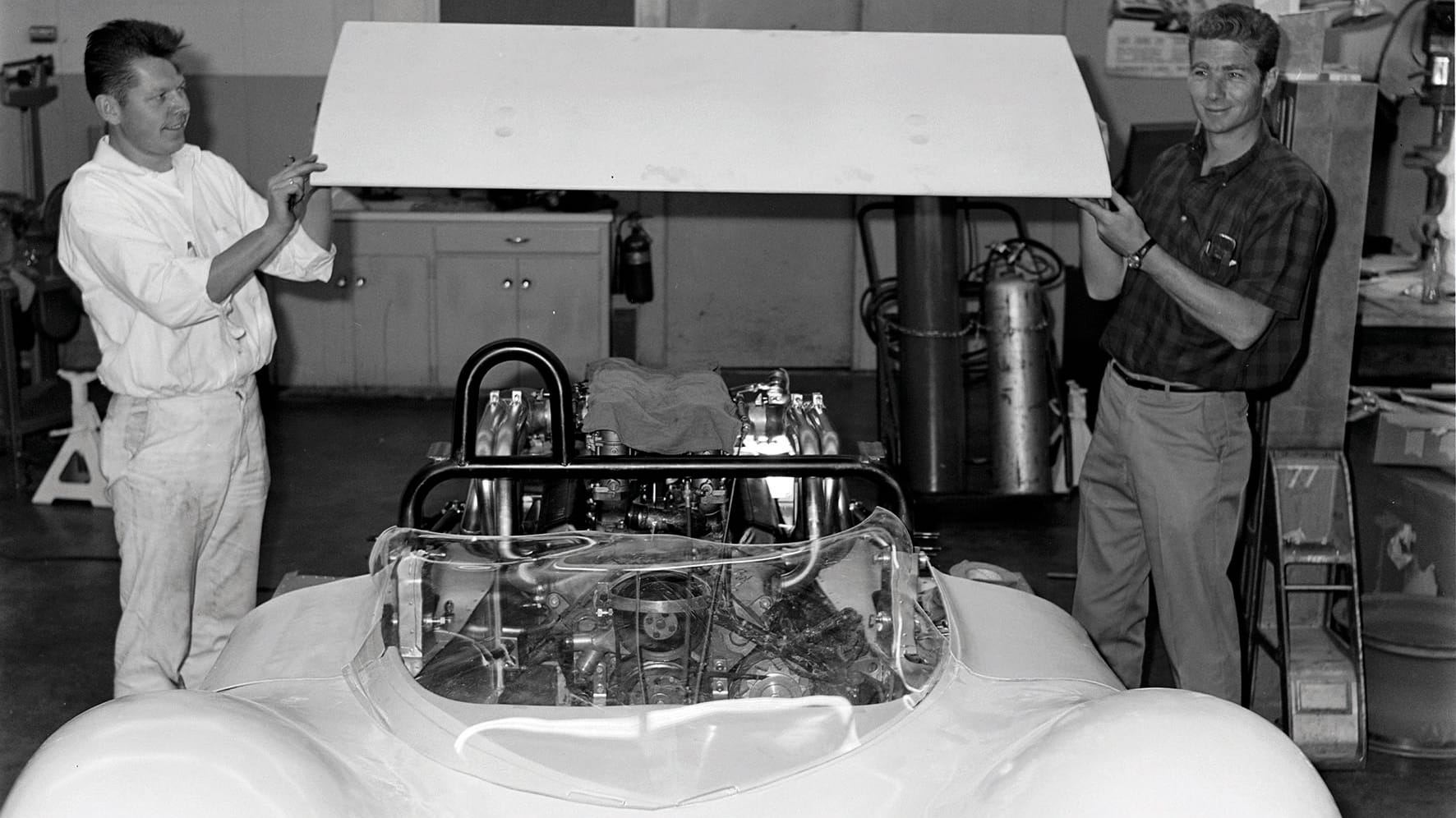
“We placed the wing pivot just behind the centre of pressure,” Hall continues, “to keep the operating force small, and also the wing would always try to rotate away from trim. It follows that if we could move it to, and hold it in, trim position with a small force, then when we released that force it would immediately return to the high-angle-of-attack – i.e. high-downforce – position.”
It would have a built-in fail-safe mode. If anything went wrong, it would revert to high-downforce mode to help slow and stabilise the vehicle.
The wing alone could have been a multi-year project. Even with assistance from Frank Winchell and Jim Musser, R&D experts from General Motors, it was a substantial undertaking. An engineer working under them, Joe Kurleto, built the first one. Kurleto had never made a wing before, but like the guys in Midland, he welcomed a challenge. He grabbed a copy of Alan Pope’s Basic Wing and Airfoil Theory and got started. The end product, made from foam and polyester composite, with strands of carbon fibre, was remarkable for its strength and lightness. But would it work as expected?
Initial validation tests fell on the shoulders of young Chevy R&D engineer Paul Van Valkenburgh. He mounted a wing on a Corvette Sting Ray in the R&D fleet to determine how close the actual downforce numbers were to what the engineers had predicted.
“I literally hole-sawed two holes in the roof on the back of the Sting Ray,” Van Valkenburgh remembers, “ahead of the rear window and just built some struts out of the rear cargo platform and mounted their first wing.” You can imagine the puzzled looks of the public as he drove down Mound Road. along the west side of the GM Tech Center in Warren, Michigan.
The wing on the Corvette was connected to transducers that measured the downforce being generated. The wing worked.
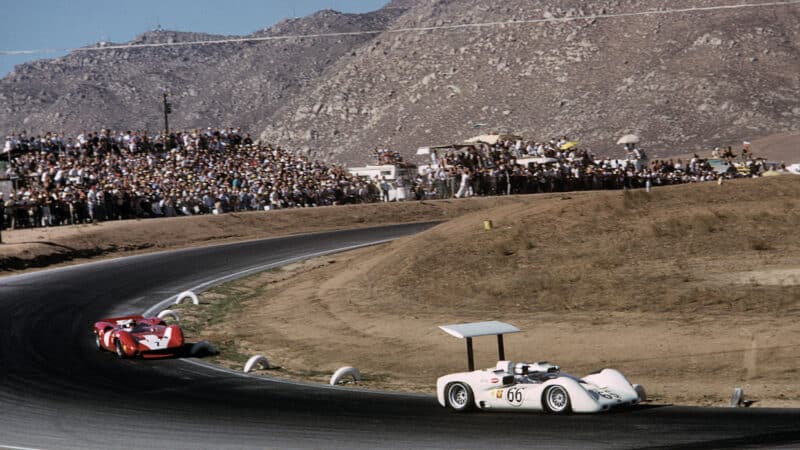
2E vs Lola T70 Mk2, Riverside, 1966
Or did it? When first tested on a Chaparral in Midland, Jim was surprised not to see downforce on the rear wheels. None.
“After taking some measurements, we figured out that while the wing was developing downforce,” says Hall, “it was also creating a low-pressure zone under the wing on the body, and the two forces were counteracting each other.”
They kept raising the wing higher and higher above the engine cover until they no longer saw the low-pressure area on the body.
“That’s why we had the wing so high up in the air,” says Hall – about 3ft above the rear fenders – “to have the wing in less disturbed air, and where it would create less of a low-pressure area on the rear deck.”
The following year, a patent for a moveable wing mounted directly on the hubs was applied for and in time duly granted.
The series the 2E would be aimed at was the brainchild of SCCA competition bosses John Bishop and Jim Kaser. If ever there was a series based on Texas principles, it was this one. The Can-Am, which originally ran from 1966-74, was uncluttered by regulations. It was capitalism – and Darwinism – in its purest form.
Bishop’s son Mitch remembers his dad telling him how he, Hap Sharp and one or two others met at SCCA official Bill Fleming’s house in Westport, Connecticut and hashed out the rules “over a bottle of scotch, and it filled exactly one page, one side of one page of a legal pad. And that was instrumental in the Can-Am, because they kept the rules simple. They basically left everything open.”
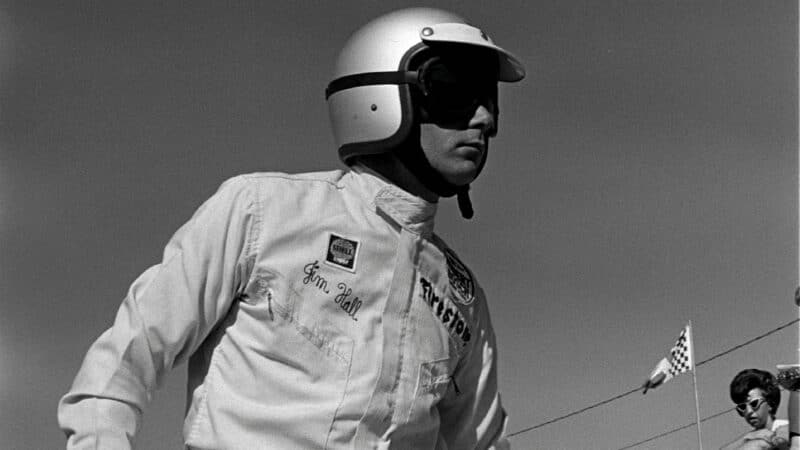
Hall finished 1966 with two second-placed finishes – ending the season just behind team-mate Hill.
Getty Images
The cars were required to have two seats and covered wheels, that was about it – and absolutely no participation trophies. Also no homologating was needed. In the Can-Am, there would be an unheard of $350,000 in total prize money, but all of it distributed based on performance. If you were a major star and travelled all the way from Britain – or Midland – and finished dead last? Tough luck.
That the series reflected Hall’s values is in no way coincidental. Although Jim has consistently downplayed his role, Kaser to his dying day said that Hall was one of his most important sounding boards in the formation of the Can-Am.
Looking back on the first season of Can-Am, the superior speed of the 2E was unmistakeable. If you look into the figures, the Texan driver set fastest qualifying time at four of the five races in which he took part. That he gets official credit for only two poles is down to the fact that he handed his car to Phil Hill at Bridgehampton and the anomaly at Mosport that forced him to start behind the considerably slower second-day qualifiers. He also set fastest lap at both the races he finished, Laguna Seca and Riverside. In addition to stepping down at Bridgehampton, he had DNFs at Mosport and Las Vegas.
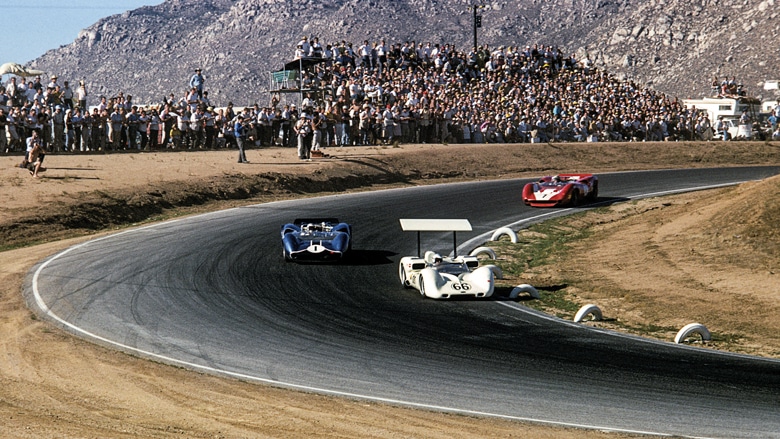
This is the appeal of the Can-Am in a single image. The world’s fastest racing cars, the world’s top drivers — in this case Jim Hall (No66), Mario Andretti (No1) and 1964 F1 world champion John Surtees — duking it out in front of massive crowds at Riverside
Bernard Cahier/The Cahier Archive
Just as significant as what the results say about the 2E is what they say about Hall, the driver. He was, after all, in the same car as one of the greatest pilots of the era, a Formula 1 world champion, and outqualified him at every venue.
“It was easy to drive. It was easy to set up. It rode on nice springs. And it was fast as hell”
“If you analyse a racecar by how many races it wins,” says Hall, “the 2E wasn’t very good. But it was a fantastic racecar in a lot of ways. Because it had the qualities that every driver wants. It was easy to drive. It was easy to set up. It rode on nice springs so that it didn’t jump around on the road. It was predictable. And it was fast as hell.
“So, I think it was a wonderful project but the guy that ran it wasn’t smart enough to win very many races, if you want to look at it that way. It was a fabulous car.”
Texas Legend: Jim Hall and his Chaparrals by George Levy (Evro Publishing) is out now.